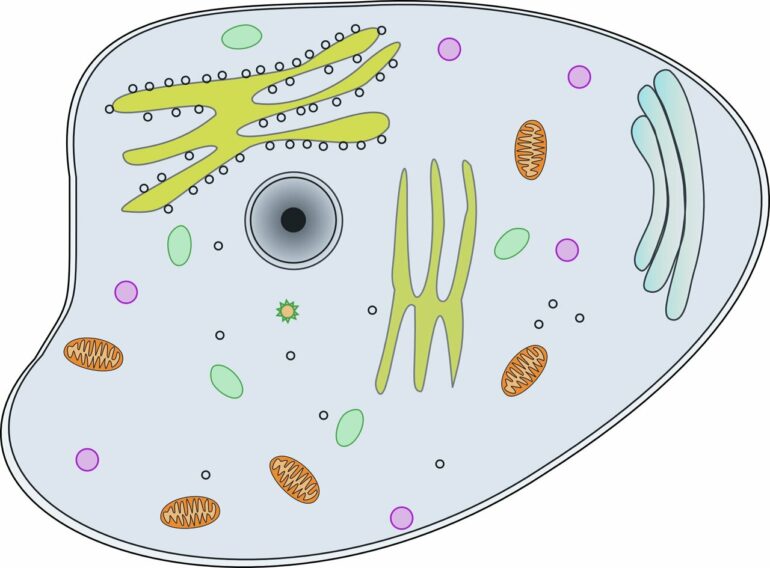The cells in our body continuously keep each other informed. They do this by exchanging, among other things, virus-like vesicles. Pascale Zimmermann’s group, from the Department of Human Genetics, has been studying these vesicles for many years. Her fundamental research is necessary to use these intercellular messengers in medicine.
For a long time so-called extracellular vesicles were considered as garbage bags. By wrapping their waste products in a membrane and then rejecting them, cells would keep things inside clean and in order. Then in the 1980s, it became clear that these extracellular vesicles were not ordinary waste containers at all. They turned out to be messengers that transfer signaling substances from one cell to another. Just like hormones, although extracellular vesicles (EVs for short) can be a lot more complex.
As messengers, EVs are involved in homeostasis, i.e. in keeping our body in a healthy biochemical and physical balance. But they also play an active role in disease. EVs can be life-saving, but also life-threatening. In the event of a heart attack, for example, they encourage heart cells to go into protective mode. But in the case of a tumor, they help the cancer cells to evade the immune system.
Scientific curiosity as a driving force
It is therefore not surprising that EVs can count on strong interest from the biomedical sciences. Because they occur as freely circulating organelles in body fluids such as blood, urine or saliva, they offer great potential to be used as early and easily detectable biomarkers. After all, EVs not only bear the biochemical earmarks of the type of cells they originate from, they can also contain information about the health of these cells. In that sense EVs that act as messengers between cancer cells and the host environment can be designated as “disease EVs.”
In theory, it is possible to detect tumors at a very early stage, using a simple saliva test. But EVs might also be used as a treatment, for delivering healing substances to diseased or damaged body tissue. Or for reprogramming cells, as a new form of cell therapy.
Unfortunately, we are not really ready yet for exploiting the potential of EVs in diagnostics or therapeutic. One of the reasons is that their underlying biology is not sufficiently understood—also a consequence of the fact that they were regarded as cell biological garbage bags for so long.
“Our lack of knowledge of the basic molecular mechanisms behind EV biology currently prevents us from developing applications,” says Pascale Zimmermann, EV researcher at KU Leuven (in the Department of Human Genetics) and the Cancer Research Center of Marseille.
The biology of these intercellular messengers must first be better understood before they can be used in medical applications. Such fundamental research has been Zimmermann’s main activity for many years. Due to the great complexity of the matter, progress has been slow, occurring in small steps.
But in October, Zimmermann, together with her colleagues from Leuven and Marseille, reached a milestone. They published their work, “PDZ scaffolds regulate extracellular vesicle production, composition and uptake,” in the journal PNAS.
In the article they provide a glimpse of the basic molecular mechanisms by which EVs are formed, programmed (with a specific message) and exchanged. These researchers have thus been able to penetrate to the core of EV biology for the first time. It places Zimmermann’s group and KU Leuven at the top of EV research.
Key role for PDZ proteins
The researchers discovered, among other things, that EVs strongly depend on a specific group of membrane-bound proteins in the cell. These so-called PDZ proteins have a long evolutionary history and are probably the result of co-evolution together with multicellularity.
“For example, a yeast cell only has two types of these proteins, while we humans have a hundred and fifty,” says Zimmermann. The link with these proteins suggests that this special system of intercellular messengers also kept pace with the development of multicellularity.
The research included a number of sub-studies into loss-of-function due to missing PDZ proteins. These studies helped demonstrate how PDZ proteins regulate the production and use of EVs. Zimmermann gives the example of a PDZ protein that functions as a messenger between the eye cells in fruit flies.
When light falls on a photoreceptor in a cell, this PDZ protein regulates the signal to protect the cells of the retina. If this PDZ protein is missing, the fruit fly will experience retinal damage.
The role that PDZ proteins play in EV biology is somewhat reminiscent of the way viruses break away from the membranes of the cells they parasitize. EVs are therefore sometimes called mini-viruses. Although they cannot “hijack” cells the way viruses do, they can also reprogram them.
The medical applications also fascinate Pascale Zimmermann, who obtained her Ph.D. in pharmaceutical sciences. But the research she has been doing for years, and which has led to this impressive publication, is thoroughly fundamental.
“We do not conduct our research with applications in mind, but purely out of scientific curiosity: it is curiosity-driven. As a result, we cannot predict what will ultimately result. But one thing is certain: without this kind of fundamental research, no rational application would be possible at all,” says Zimmerman.
More information:
Monica Castro-Cruz et al, PDZ scaffolds regulate extracellular vesicle production, composition, and uptake, Proceedings of the National Academy of Sciences (2023). DOI: 10.1073/pnas.2310914120
Citation:
Intercellular messengers reveal themselves (2023, October 27)



